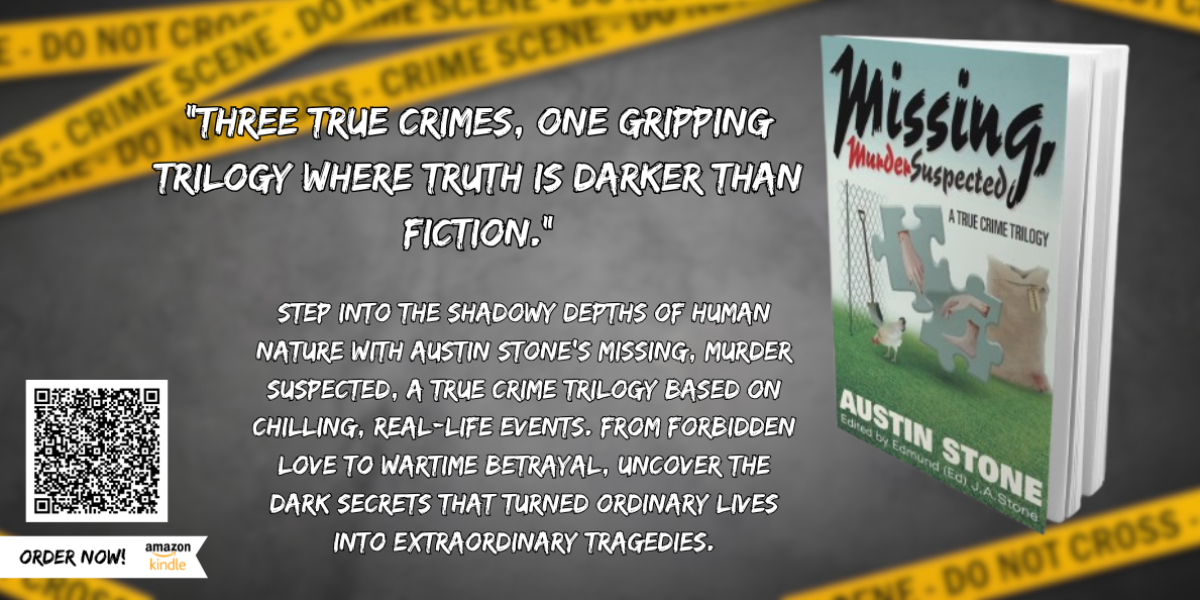By: Brenda J. Adams
True crime stories have long captivated audiences with their gritty depictions of often horrific events, their detailed investigations, and their exploration of the darker aspects of human nature. However, Austin Stone’s Missing, Murder, Suspected, edited posthumously by Edmund J.A. Stone, offers a fresh perspective within the true crime trilogy format.
While grounded in real-life murder cases, Stone’s work diverges from the traditional crime narrative by shifting the focus from the crime itself to the emotional and psychological complexities surrounding the individuals involved. In this article, we will explore how Missing, Murder, Suspected presents an alternative approach to true crime storytelling and invites readers to reconsider how we view crime and its consequences.
Moving Beyond the Crime
Most true crime stories are structured around the event itself: the murder, the investigation, the trial. These stories often focus on uncovering the facts, with limited attention paid to the emotional or psychological motivations behind the crime. In contrast, Missing, Murder, Suspected takes a different approach. Instead of solely recounting the details of the crimes, Stone delves deeply into the lives of the characters involved, particularly their emotional landscapes.
The trilogy doesn’t just ask, “Who committed the crime?” or “How did they do it?” but rather, “Why did it happen?” By shifting the focus to the emotional and moral struggles of the individuals, Stone encourages readers to move beyond the conventional notion of crime as a simple act of evil. His characters are complex, multi-dimensional beings—flawed, human, and often caught in a web of conflicting emotions. This focus on internal conflict invites readers to rethink their understanding of crime, moving away from black-and-white judgments to a more nuanced and empathetic perspective.
Moving Away from the Villain-Victim Dichotomy
Traditional true crime narratives often rely on a clear distinction between the villain and the victim, presenting the perpetrator as an irredeemable figure and the victim as an innocent bystander. Missing, Murder, Suspected, however, avoids this oversimplification. Instead of creating clear-cut heroes and villains, Stone presents morally ambiguous characters who cannot be easily classified as one or the other.
In A House of Horror, for instance, the perpetrator of the crime is not a mindless monster but a person whose actions are shaped by personal history, psychological factors, and emotional struggles. This blurring of the lines between good and evil encourages the reader to confront uncomfortable questions about human nature, such as: “What drives someone to commit murder?” and “What are the emotional and moral consequences of such an act?”
Stone’s refusal to simplify his characters into heroes and villains prompts readers to think more deeply about the nature of morality, love, hate, and guilt. His stories suggest that human beings are complex and that the motivations behind a crime are often far more complicated than they appear at first glance.
A New Approach to True Crime Storytelling
By focusing on the emotional and psychological aspects of true crime, Missing, Murder, Suspected introduces a distinctive twist on the genre. Stone’s stories are not just about uncovering the details of a crime—they are about understanding the inner lives of the people involved. Through his vivid character development and exploration of complex emotions, Stone invites readers to see crime through a more human lens.
In a traditional true crime story, the focus is often on the pursuit of justice, the punishment of the perpetrator, and the closure for the victim. However, Missing, Murder, Suspected expands on this, offering readers a deeper understanding of the psychological and emotional consequences that linger long after the crime has been committed. The trilogy asks readers to confront the complexities of human behaviour, questioning the nature of guilt, love, revenge, and redemption.
Summary
Missing, Murder, Suspected stands out as an innovative work that broadens the possibilities of true crime storytelling. Austin Stone guides readers beyond the crime scene, offering a psychological and emotional exploration of the people involved. The trilogy questions traditional crime narratives by delving deep into the complexities of human relationships, making it a compelling choice for anyone interested in true crime, psychology, or storytelling that goes beyond the surface.
If you’re seeking an alternative to the typical crime narrative and are looking for a deeper, more reflective approach to the genre, Missing, Murder, Suspected is well worth exploring. With its compelling characters, psychological depth, and thought-provoking themes, this trilogy may leave you questioning not only the nature of crime but also the nature of humanity itself.

















